The February unemployment rate dropped yet again on a huge decline of those not considered part of the labor force anymore. The official unemployment rate is now 5.5%, a -0.2 drop from last month. The labor participation rate is at 37 year record lows. From a year ago, the number of people considered not in the labor force has increased by 1.5 million. Pundits will extol the dropping unemployment rate as evidence of a healthy employment situation, yet the never ending increase of those no longer in the labor force is most disconcerting. That is no way to lower the unemployment rate.

This article overviews and graphs the statistics from the Employment report Household Survey also known as CPS, or current population survey. The CPS survey tells us about people employed, not employed, looking for work and not counted at all. The household survey has large swings on a monthly basis as well as a large margin of sampling error. The CPS has severe limitations, yet, it is our only real insight into what the overall population are doing for work.
The ranks of the employed grew by 96,000 this month. This is within the margin of error of the survey. From a year ago, the employed has increased by 2.996 million. This is great actually, well beyond what is needed to keep up with increased population growth.

Those unemployed decreased -274,000 to stand at 8,705,000. From a year ago the unemployed has decreased by -1.682 million, which is if one thinks about it, isn't that much in comparison to the number of employed increase. Below is the month change in unemployed and as we can see, this number normally swings wildly on a month to month basis.

Those not in the labor force increased by 354,000 persons and to bet 92,898,000. The below graph is the monthly change of the not in the labor force ranks. Notice the increasing swells and wild monthly swings. Those not in the labor force has increased by 1,500,000 in the past year.

The labor participation rate is at 62.8%, a -0.1 change from last month. Those aged 16 and over either working or looking for work is still at record lows, as shown in the below graph.

The low labor participation rate is not all baby boomers and people entering into retirement. Below is a graph of the labor participation rate for those between the ages of 25 to 54. These are the prime working years, so one cannot blame retirement and college on the declining participation rate. The 25 to 54 age bracket labor participation rates have not been this low since the 1980's recession and the rate stands at 81.0%.
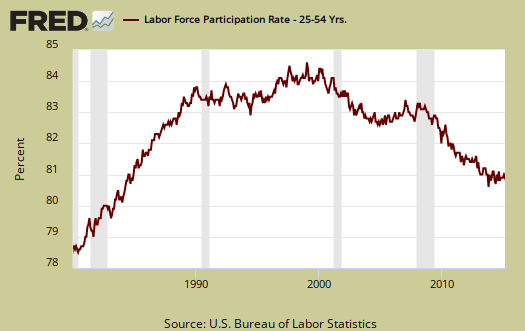
The civilian labor force, which consists of the employed and the officially unemployed, decreased by -178 thousand this month. The civilian labor force has grown by 1,314,000 over the past year. New workers enter the labor force every day from increased population inside the United States and immigration, both legal and illegal.

In spite of wild statistical swings, those not in the labor force often grows faster than the population which has the potential to work. Below is a graph of those not in the labor force, (maroon, scale on the left), against the noninstitutional civilian population (blue, scale on the right). Notice how those not in the labor force crosses the noninstitutional civilian population in growth and the accelerated growth started happening right in 2008. This increase cannot be explained by retiring baby boomers alone.

Below is a graph of the civilian labor force, or the official employed plus unemployed, in maroon, scale on left, against those not in the labor force, in blue, scale on right. Notice how those not in the labor force as a trend exceeded those considered employed and unemployed starting around mid 2009. What we have seen is a never ending growing segment of the population that is considered neither employed or unemployed, i.e. not in the labor force, increasing, above the trend line of those who would be naturally dropping out, such as the retired and those in school. Not in the labor force figures do include retirees and the size of the population greater than age 65 has grown.

Those considered employed as a ratio to the total Civilian noninstitutional population now stands at 59.3%, which is more no change from last month. For the interested, there is a relationship between the employment-population ratio and the labor participation rate (LPR): employment-population ratio = LPR * (1 - unemployment rate).
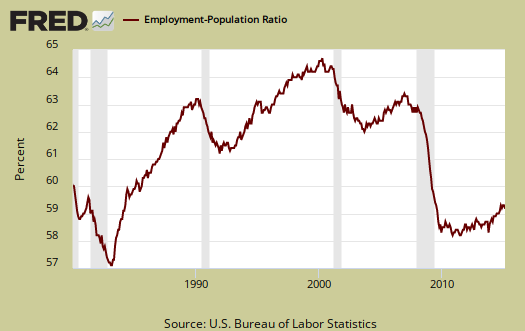
There are millions of people who need full-time jobs with benefits who simply cannot get them and only obtain part-time work. Those forced into part time work is now 6,635,000, an decrease of -175,000 from last month. This is the best news of this report. Those stuck in part-time hours has declined by 569 thousand over the past year, which isn't that much. although better than increasing! The below graph shows levels of people who could only get part time hours have remained elevated since the recession.

There are two categories of those working part-time hours. Those who could only get part-time jobs and those working who got their hours cut due to businesses not having enough work for them. The number of people who could only get part-time work declined slightly by -34 thousand to 2,426,000 as shown below.
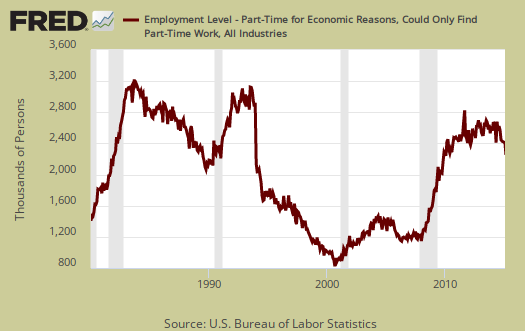
People can also be stuck with part-time hours due to slack working conditions,which barely declined -165,000 and stands at 3,847,000. From a year ago those who are getting their hours slashed due to weak economic demand has declined by -9.7%. Below is a graph of forced into part-time work because they got their hours cut, as a percentage of the total employed. This is a recession economic indicator, see how the line slope matches strongly the graph gray recession bars in the below graph.
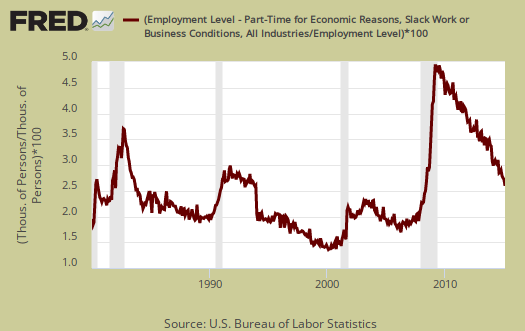
U-6 is a broader measure of unemployment and includes the official unemployed, people working part-time hours because that's all they can get and a subgroup not counted in the labor force but are available for work and looked in the last 12 months . The U-6 alternative unemployment rate still leaves out some people wanting a job who are not considered part of the labor force. U-6 dropped three tenths of a percentage point and stands at 11.0%.
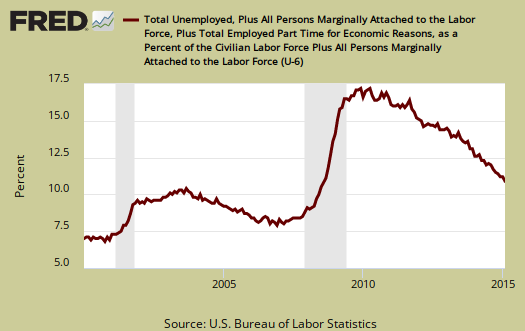
The long term unemployed, or those unemployed for 27 weeks and over, dropped by -91,000 to stand at 2,709,000 people. From a year ago the long term unemployed ranks have decreased by -28.8%, but this does not mean at all those folk found work. Some must be dropping out of the labor force, giving up.
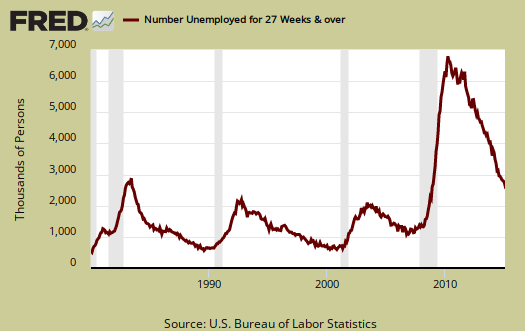
The marginally attached are people not in the labor force because they have not looked for a job in the last month, but have looked for a job in the last year. This number has ballooned since 2007 and not returned to pre-recession levels. It's like a perpetually static figure at this point, it just never seems to change significantly, statistically speaking. The graph below is the number of people considered marginally attached to the labor force, currently at 2.159 million. The marginally attached should only be viewed as a long term trend for the figures are also not seasonally adjusted.
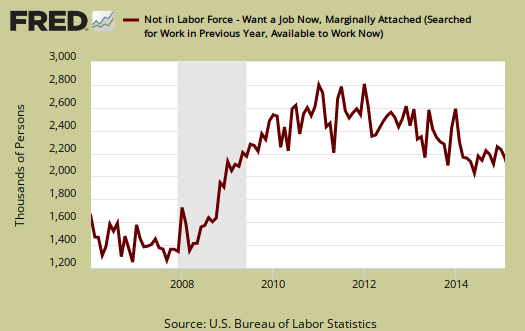
The discouraged worker statistics are about people, not counted as part of the civilian labor force, who not only want a job, but also looked for one in the last year. & nbsp;These people aren't job hunting now because they believe there are no jobs out there. These figures also have no change. Below is the graph of discouraged workers, currently at 732 thousand people and are a subset of the marginally attached.

Our favorite statistic from the CPS survey is how many people who are considered not in the labor force, report they want a job now. It is a direct survey question from the CPS. The survey asks people who are not being counted in the unemployment statistics and official unemployment rate if they want a job. The number who answer yes currently stands at 6,538,000, a very large number of people. Those who are not counted yet report they want a job includes the discouraged workers and marginally attached and is seasonally adjusted. This figure has increased by 7.7% from a year ago and also increased 180,000 from last month. This figure should drop along with the unemployment rate as these people rejoin the job hunt if the labor situation was really great, so something is very wrong for workers and job seekers with this kind of annual gain.

The average length of unemployment is 31.7 weeks and a year ago was 36.9 weeks. That's over seven months to be without a paycheck.
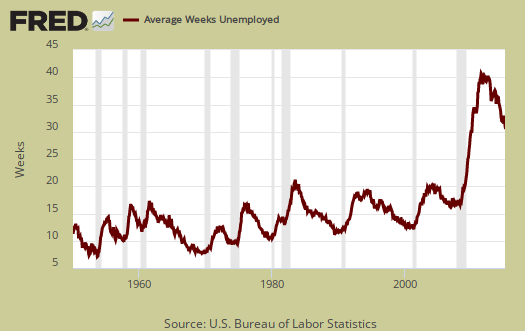
The median time one is unemployed, which means 50% of people have gotten a job in this amount of time is 13.1 weeks. A year ago this figure was 16.2 weeks, so finding job has improved, but only for some. Over three months without work for half of the people looking is still a very long time. Most are living paycheck to paycheck and also get denied unemployment benefits.

The household survey gives the reason for new unemployment status. Job losers and those who completed temporary jobs decreased b -62,000 and stands at 4,180,000. Below is a graph of job losers by levels.
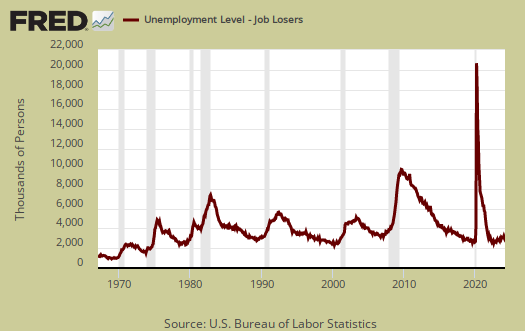
People join the ranks of the unemployed because they were laid-off, fired, they quit, the job was temporary and thus ended, they entered the labor force for the first time and re-entrants. Re-entrants are people with work experience, yet have been considered not in the labor force for some time. Recall to be considered unemployed one has to be actively searching for a job or expecting to be recalled and on temporary layoff. Re-entrants decreased by -174 thousand people this month to 2,655,000. Below are re-entrants as a percentage of the total unemployed. As you can see, as jobs and opportunities appear, people re-enter the labor force looking to snap one of those jobs. If there are a lot of job opportunities out there, the slope of this graph should spike up.
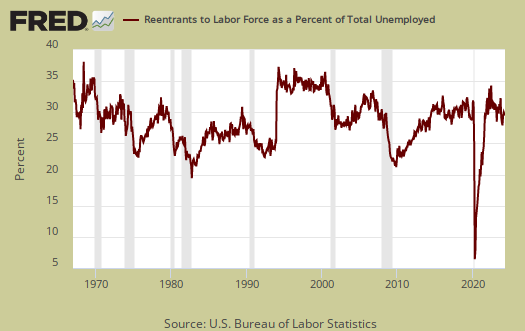
Re-entrant unemployed levels, graphed below, are yet another sign on how people are not finding work, giving up, then dropping out of the labor force and then trying again to get a job. If the job market was good for a long period we'd see this statistic drop as new entrants would have found work instead of being once again officially counted as unemployed.
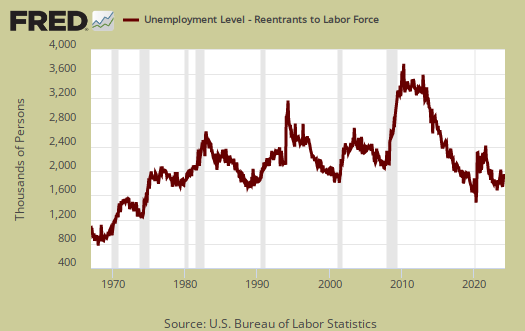
This month's household survey shows some continuing trends over a period of months. Those not in the labor force continues to grow and those stating they want a job who are not counted increases. These figures belie the reported payrolls growth to some extent, as if there is a huge segment of the true working age population who are just being marginalized, cast to the side and swept under the rug. Here are our past overviews CPS unemployment statistics, only graphs revised.

Hiring rate only 50%
Over 11 million more are "not in the labor force" since the Great Recession officially ended in June 2009 --- about the same number of jobs that were created during that same period time. What does this mean? That 50% of new entrants are finding temp or low-paying jobs, while the other 50% are dropping out of the labor force?
not so easy
Labor flows are not so simple. There are people entering the labor force due to immigration, legal and illegal and those coming of age and seeking a job. There are those leaving the labor force due to retirement, then people become sick, disabled, go to prison and join the military.
We know from the payrolls survey a huge percentage of new jobs are low paying ones in restaurants, leisure and hospitality.